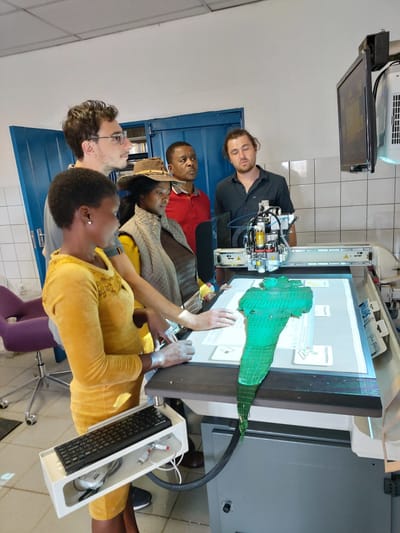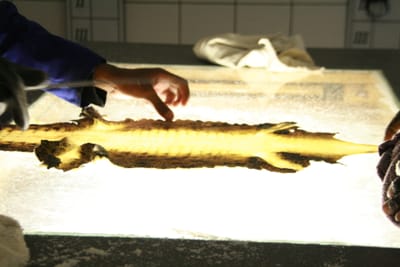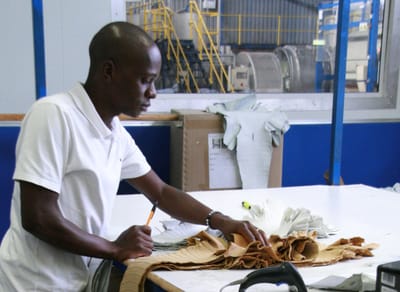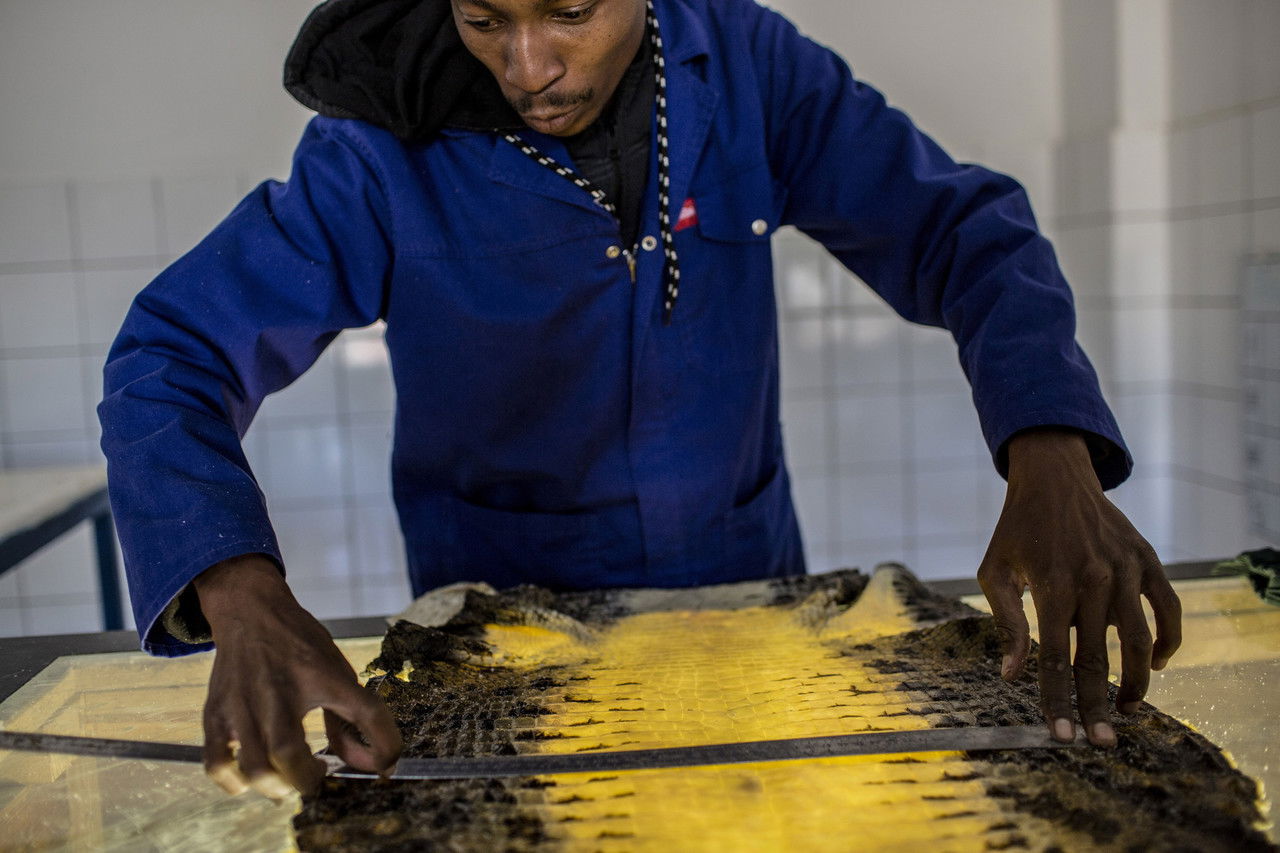GRADING



TANNING QUALITY
The tanning quality of our leather reflects the excellence of the tanned leather, evaluated and assessed by means of visual inspection and laboratory tests, to ensure the leather meet strict, predetermined leather criteria. The tanning quality for all grades of skins are similar and constant, it is the desired result of uniform, calibrated tanning, coloring and finishing processes. Le Croc's leather contains all the tanning qualities necessary to meet the most particular requirements of fashion, and the timeless elegance of luxury.
LEATHER SELECTION
The grade allocated to a hide, is a reflection of the expected superior usable cutting area (cutting yield) of that particular hide. The final cutting value of a hide, to a leather craftsman, depends on the optimum use of the available cutting yield of a skin, for a specific, predetermined application. The size and 'nesting' of the desired cut patterns, determines both the size and grade of the skin required for a particular product. The unique scale pattern of a crocodile skin, as well as the type of finish, shades and color, also influence the nesting of patterns, leather selection and final cutting value.
In general, larger patterns require superior grades, especially if the leather is required to be prepared in an aniline finish with pastel colors in light shades. Leather products that require smaller patterns, without symmetrical and center line positioning, can use lower grade leather without compromising on the quality and appearance of the final leather product.
Experienced leather craftsmen will select multiple hides of varying grades to manufacture products. This selection ensure that the most valuable leather available is reserved for the larger front panels while lesser grade leather are used for unexposed or smaller panels. This correct grade leather selection ultimately reduce costs, wastage and improve product quality. Le Croc's experience and understanding of the application of our crocodile leather, will assist the customers' leather selection to ensure the cutting value is optimized and perfectly match for the intended product application and desired finish.
 LEATHER GRADING METHODOLOGY
LEATHER GRADING METHODOLOGY
The Nile crocodile has evolved on the African continent over 200 million years. They retained their primitive ancient aquatic, physical and social characteristics as opportunistic apex predators, often displaying dominance, territorial and antagonistic behavior, even when bred in captivity. These unique predator characteristics also results in skins defects on hides, which proudly display the hallmark of genuine crocodile leather.
Our crocodile leather is graded according to the accepted international grading methodology applied by international buyers and graders. It is primarily based on the expected cutting yields, taking into account the tolerance levels for defects prevailing within a particular market segment. In case of 'Belly skins' the primary available cutting area is the area situated between the prominent bony scutes on the flanks (sides) and the front (top) and hind legs (bottom). These valuable Belly skins are normally represented by a rectangle (see diagram below).
The highest grades (first and second grades) are allocated to leather that are blemish free within the critical grading area (square scales in central belly area) and with only minor blemishes on the flanks or perimeter cutting area, rendering 70-90% of the available cutting area blemish free. These hides are normally used to produce large leather panels requiring a scale pattern centerline, dyed in light pastel colors for an aniline leather finishes. Aniline leather are the most natural, soft and gracefully supple, of all leather types. This highly sought-after leather are priced at a premium and it is in short supply.
Medium grade hides are leather that either has a lesser cutting yield or alternatively, where the blemishes or defects are of such a light intensity that the leather can still be used for aniline finishes, but primarily in colors with darker shades.
Low grade hides are leather with clearly visible surface defects on sections (quarters) of the the available cutting area of the leather. Alternatively, lower grade hides have internal collagen blemishes which remain visible after coloring and finishing. The number of quarters containing visible defects, occurring within the 4 quadrant rectangle shaped grading area, will determine the ultimate grade of the skin.
VALUE
The pricing of the leather is reflective of the grade allocated to the hide, which in turn reflects the the versatility of use, including cutting value, finishes and color that can be applied to a hide. The location and intensity of the defects are important factors which influence the grade allocated to, and the value of, the hide. The types of product to be manufactured, size of the panels and nesting thereof, as well as the color and type of finish, ultimately determines the grade (and value) of the leather required to manufacture a product.
The tanning quality of our leather reflects the excellence of the tanned leather, evaluated and assessed by means of visual inspection and laboratory tests, to ensure the leather meet strict, predetermined leather criteria. The tanning quality for all grades of skins are similar and constant, it is the desired result of uniform, calibrated tanning, coloring and finishing processes. Le Croc's leather contains all the tanning qualities necessary to meet the most particular requirements of fashion, and the timeless elegance of luxury.
LEATHER SELECTION
The grade allocated to a hide, is a reflection of the expected superior usable cutting area (cutting yield) of that particular hide. The final cutting value of a hide, to a leather craftsman, depends on the optimum use of the available cutting yield of a skin, for a specific, predetermined application. The size and 'nesting' of the desired cut patterns, determines both the size and grade of the skin required for a particular product. The unique scale pattern of a crocodile skin, as well as the type of finish, shades and color, also influence the nesting of patterns, leather selection and final cutting value.
In general, larger patterns require superior grades, especially if the leather is required to be prepared in an aniline finish with pastel colors in light shades. Leather products that require smaller patterns, without symmetrical and center line positioning, can use lower grade leather without compromising on the quality and appearance of the final leather product.
Experienced leather craftsmen will select multiple hides of varying grades to manufacture products. This selection ensure that the most valuable leather available is reserved for the larger front panels while lesser grade leather are used for unexposed or smaller panels. This correct grade leather selection ultimately reduce costs, wastage and improve product quality. Le Croc's experience and understanding of the application of our crocodile leather, will assist the customers' leather selection to ensure the cutting value is optimized and perfectly match for the intended product application and desired finish.
 LEATHER GRADING METHODOLOGY
LEATHER GRADING METHODOLOGYThe Nile crocodile has evolved on the African continent over 200 million years. They retained their primitive ancient aquatic, physical and social characteristics as opportunistic apex predators, often displaying dominance, territorial and antagonistic behavior, even when bred in captivity. These unique predator characteristics also results in skins defects on hides, which proudly display the hallmark of genuine crocodile leather.

Our crocodile leather is graded according to the accepted international grading methodology applied by international buyers and graders. It is primarily based on the expected cutting yields, taking into account the tolerance levels for defects prevailing within a particular market segment. In case of 'Belly skins' the primary available cutting area is the area situated between the prominent bony scutes on the flanks (sides) and the front (top) and hind legs (bottom). These valuable Belly skins are normally represented by a rectangle (see diagram below).
The highest grades (first and second grades) are allocated to leather that are blemish free within the critical grading area (square scales in central belly area) and with only minor blemishes on the flanks or perimeter cutting area, rendering 70-90% of the available cutting area blemish free. These hides are normally used to produce large leather panels requiring a scale pattern centerline, dyed in light pastel colors for an aniline leather finishes. Aniline leather are the most natural, soft and gracefully supple, of all leather types. This highly sought-after leather are priced at a premium and it is in short supply.
Medium grade hides are leather that either has a lesser cutting yield or alternatively, where the blemishes or defects are of such a light intensity that the leather can still be used for aniline finishes, but primarily in colors with darker shades.
Low grade hides are leather with clearly visible surface defects on sections (quarters) of the the available cutting area of the leather. Alternatively, lower grade hides have internal collagen blemishes which remain visible after coloring and finishing. The number of quarters containing visible defects, occurring within the 4 quadrant rectangle shaped grading area, will determine the ultimate grade of the skin.
VALUE
The pricing of the leather is reflective of the grade allocated to the hide, which in turn reflects the the versatility of use, including cutting value, finishes and color that can be applied to a hide. The location and intensity of the defects are important factors which influence the grade allocated to, and the value of, the hide. The types of product to be manufactured, size of the panels and nesting thereof, as well as the color and type of finish, ultimately determines the grade (and value) of the leather required to manufacture a product.


